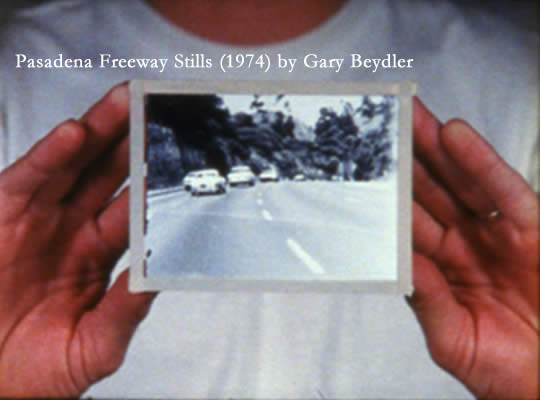 Los Angeles Filmforum continues its film screening series Alternative Projections: Experimental Film in Los Angeles, 1945-1980 on March 4th with Material Concerns at the Spielberg Theatre at the Egyptian, 6712 Hollywood Blvd., Los Angeles CA 90028 ( Sunday March 4, 2012 7:30 pm)
Los Angeles Filmforum continues its film screening series Alternative Projections: Experimental Film in Los Angeles, 1945-1980 on March 4th with Material Concerns at the Spielberg Theatre at the Egyptian, 6712 Hollywood Blvd., Los Angeles CA 90028 ( Sunday March 4, 2012 7:30 pm)
One of the key concerns of experimental film, in the tradition of all modern art, is the stuff of film itself: how it is made, what is it made of, what are the basic elements of the camera, the celluloid, and the projector.
In experimental film, focusing on the materials and procures of film-making has come to be known as structuralist film-making, with a hey-day from the late 1960s through the mid-1970s, but continuing in much work today. These are several classic examples made in Los Angeles, with precise control over the instruments of filmmaking, the depth of good art, and (more often than not) a fair dose of wit.
Screening (Subject to Change):
Screen (Pat O’Neill, 1969, digital (originally 16mm), color, silent, 4min.)
A less-well known work by O’Neill, originally intended as an installation.
Venusville (Chris Langdon & Fred Worden, 1973, 16mm, color, sound, 10min.)
No montage, no human subjects, minimal visual content, and the artists basically pissing on the fourth wall by calling attention in every way possible to the artifice of what they’re doing. An anti-film school film made at film school. – Mark Toscano
Pasadena Freeway Stills (Gary Beydler, 1974, 6:00, 16 mm, color, silent, 6:00)
A simple but stunning demonstration of how motion pictures move, recalling (and perhaps inspired by) the mechanism of the Mutoscope, the main rival to the Kinetoscope and Cinematograph in the 1890s.
Picture and Sound Rushes (Morgan Fisher, 1973, 16mm, color, sound,, 11:00)
Picture and Sound Rushes includes synchronous sound footage of Fisher explaining the premise of the film that is being shot. He improvises his dialogue from notes to which he refers while the camera is rolling. At predetermined thirty-second intervals, the film alternates between sync sound, wild sound over black, MOS or silent footage of Fisher speaking, and silence over black. After the segments of silence over black (called the “null case” in the film) Fisher’s reappearance comes as something of a relief. — William E. Jones, “Morgan Fisher: An Impersonal Autobiography”
Stasis (David Wilson, 1976, 16mm, 8:00)
The original camera footage for STASIS is an 8-minute, 8:1 camera zoom. That footage was then printed with an equal but complimentary optical zoom resulting in an image of apparent stillness. Stasis is the image of the stillness in motion. Stasis counterpoints the movements of running water in a stream within a still-camera shot, with a steady zoom from without the filmed image (including subtle sprocket holes and frame lines) to a close-up within the image.
“A zoom-out camera shot of a stream in Western Colorado is compensated for by a reverse zoom in rephotography. The tension between these movements creates a drama and a commentary on cinematic illusionism.” -Roberta Friedman
Photogrammetry Series (Louis Hock, 1977, 16mm, color, sound, 8min)
Future Perfect (Roberta Friedman & Grahame Weinbren, 1978, 16mm, color, sound, 11 min.)
“A film which, always unfinished, looks forward to a future when it (and everything else) will be perfect.” (Roberta Friedman & Grahame Weinbren)
I Kiss the Dear Fingers So Toil-Worn For Me (Craig Rice, 1981, 16mm, 5:30)
More information at alternativeprojections.com
Tickets: General $10, Students/seniors $6; free for Filmforum members
Advance ticket purchase available through Brown Paper Tickets.
http://www.brownpapertickets.com/event/228852

